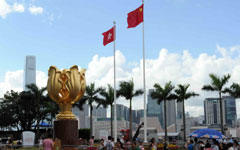China-Vietnam border trade cools amid bilateral tension
(Xinhua) Updated: 2014-06-13 11:16NANNING - There is mounting evidence of a serious cooling in China-Vietnam border trade as tensions between the two countries over maritime disputes continue.
The import and export volume of Guangxi Zhuang autonomous region, which borders Vietnam, reached $3.31 billion in May, down 8.1 percent from April, according to customs statistics released on Tuesday.
Vietnam is the country with which Guangxi does most trade.
|
 |
 |
China remains Vietnam's biggest trade partner.
The scene on the ground also suggests a major decline in trade. At Puzhai Port in Pingxiang city, the largest Sino-Vietnamese cross-border trade zone, the number of trucks carrying goods has decreased significantly.
"Three months ago, trucks carrying watermelons from Vietnam to China would wait in a 20-km line to enter China. Usually it would take six days," said Tan Xinggui, a Chinese merchant who has been in the transportation business for eight years at the border.
"Now the truck flow is far below normal," Tan said.
At a rosewood market in Pingxiang, there were hardly any buyers this week. "I used to sell these black rosewood furniture sets for 180,000 yuan ($29,318), now I have to sell them for 160,000 yuan," said a Vietnamese retailer in the market.
Most China-Vietnam border trade business people are taking time out, closely watching the situation to see how it develops, and some no longer trust their business partners in Vietnam, according to Wang Tian, an official with the Pingxiang City Commerce Bureau.
"Many fear that the Vietnamese will fail to pay after they receive our commodities," Wang said.
Such fear of hostility has been fuelled by the series of riots that hit foreign companies in southern and central Vietnam in May, leaving five Chinese nationals dead, around 20 foreign factories burned down and some 1,100 foreign companies affected.
Anti-China looting and arson in Vietnam began after Vietnamese ships and personnel repeatedly harassed a Chinese oil company operating normally in waters only 17 nautical miles (27 km) from China's Xisha Islands and about 150 nautical miles (241 km) from Vietnam in the South China Sea.
- China accounts for 41.75% of Vietnam's rice export
- Unrest in Vietnam shatters investor confidence
- Vietnam riots 'will hurt investment from China'
- From mainland to 'made in Vietnam'
- China remains Vietnam's 3rd largest export destination in January
- China remains Vietnam's biggest trade partner in 2013
- CPC official calls for SME co-op between China, Finland
- China-Vietnam border trade cools amid bilateral tension
- Alibaba's first US presence 11 Main debuts
- Fair, legal business urged for sound market
- New China-Italy Center is a 'win-win' for growth
- Mobile gaming to grow further in 2014
- Zhaopin IPO raises $76 m on NYSE
- Shell senses huge profit potential in China

















